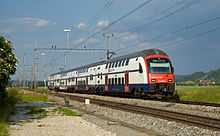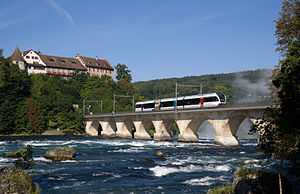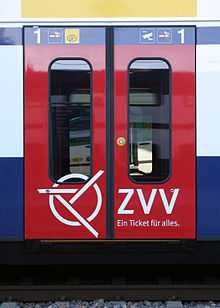Zürich S-Bahn
 Siemens RABe 514 "DTZ" on the S8 service, which extends into Thurgau  1960s rolling stock (RBe 540 multiple units and rebuilt EW I coaches) is still used for relief trains  The "DPZ" trains form the largest part of the fleet (Re 450 locomotive, B and AB coaches, Bt control car)  SOB FLIRT on the S40 service  THURBO operated Stadler GTW on the S33 service  RABDe 510 "Mirage" trainsets, used until 2008, now scrapped | ||||||||||||||||||||||||||
The Zürich S-Bahn (German: S-Bahn Zürich) system is a network of rail lines that has been incrementally expanded to cover the ZVV area, which comprises the entire canton of Zürich and portions of neighboring cantons (Aargau, Schaffhausen, Schwyz, Thurgau and St. Gallen), with a few lines extending into Germany. The network is one of many commuter rail operations in German speaking countries to be described as an S-Bahn.
The entire ZVV S-Bahn network went into operation in May 1990, although many of the lines were already in operation.
The lines of the S-Bahn network are numbered from S2 to S55, but the numbering is rather sporadic, with several missing numbers (e.g. S19, S20).
Unusual among rapid transit services, the Zürich S-Bahn provides first class commuter travel; about one-fifth of seats on each train are first class.[4]
History
Gold Coast Express
The first step in developing Zürich's rail system which eventually led to the establishment of the S-Bahn was the establishment of the so-called Gold Coast Express (German: Goldküstenexpress) on 26 May 1968 between Zürich Stadelhofen and Rapperswil via Meilen along the wealthy north shore of Lake Zürich, popularly known as the Gold Coast. It operated a regular schedule every half hour, with the total journey time for the distance of 36 kilometres (22 miles) reduced from the previous 60 to 40 minutes. After World War II, there was a rapid expansion of commuting to Zürich from the former wine-growing villages along the railway line, which originally opened in 1894. As a result commuters complained that the trains were overcrowded, slow and often delayed.[5]
The canton of Zürich began to develop a project to improve the railway in the 1950s. Because it was not used by either long-distance passenger or freight trains, improvements in local services were possible. Double track sections were built between Kuesnacht and Herrliberg and between Stäfa and Uerikon, along with new stations. The main problem was finance. Development of the line would only serve local interests and would not lead to increased revenue for Swiss Federal Railways (SFR). At the time the canton and cities affected could not fund improvements to an SFR line, so the law was changed to allow local contributions.[5]
The most striking feature of the improved railway was the three-car claret-coloured RABDe 12/12 electric multiple units. These had good acceleration and braking performance and immediately became known as "Mirages", after the jet fighters. The modern features of the Mirages included automatically closing doors, which allowed short stops at stations and a reduction in travel time.[5]
U-bahn rejected

On 30 May 1959 some voters put two proposals to the Zürich City Council. The first would have allocated CHF 200,000 for a study on the construction of a two-line U-bahn (underground railway) with lines from Enge to Kloten and from Altstetten to Tiefenbrunnen; but it was opposed by the majority of the City Council and failed. The second motion proposed the establishment of a company to build and operate a Zürich U-Bahn. The city had already considered such a proposal and opposed it, on the basis that Zürich was not big enough for an underground railway, and it would cost too much.[6] In a referendum on 14 February 1960, 69.8% of voters voted "no" to the proposal.[7]
Following further work and the enactment of a new transport act, the regional public transport authorities presented a new proposal for a combined regional U-Bahn and S-Bahn system (that is, a suburban network based on the existing rail system) . From Zürich Airport, an U-Bahn line would run via Glattbrugg, Oerlikon, Hirschenwiesen, Central, Zürich Main Station, Stauffacher and Altstetten to Dietikon. Much of the line would have run above ground. The second part of the proposal was the "Zürichberg network", a line from Zürich main station via a new tunnel under the Zürichberg to Dietlikon. The proposed construction of an underground station in Museumstrasse on the north side of the main station was intended to ease the pressure on the main station.[8] On 20 May 1973 this proposal was rejected in a referendum, with the "no" vote as high as in the previous referendum.[9] At the referendum, little opposition had been expressed against the proposed S-Bahn lines.[10]
Coordination and construction of the S-Bahn

Rail is a major element in Zürich's public transport system, and its upgrade required close collaboration between the Canton of Zürich and Swiss Federal Railways (SBB), the owner of most of the railways. The SBB had insufficient resources for a substantial upgrade of commuter services. On the other hand, the canton of Zürich could not fund an alternative transport network.[11]
The first step towards cooperation came in 1978 with the establishment of a Transport Fund providing CHF 40 million annually for urban transport. The routes of today's S-Bahn were established in a debate in the cantonal Council on 19 June 1978. Alternative "eastern" and "western" options were discussed. Under the western option the northern end of the central tunnel from the main station would have connected with Oerlikon, while in the eastern option it would have tunneled under the Zürichberg and ended near Dietlikon. The cantonal Council chose the eastern option by 85 votes to 36.[10]
At a referendum on 29 November 1981, Zürich's voters approved by a two-thirds majority a loan of CHF 520 million for the construction of the core of the S-Bahn. The new route runs from the main station through the Hirschengraben tunnel to Stadelhofen, where the line branches off to Tiefenbrunnen, and continues through the Zürichberg Tunnel to Stettbach (new underground station) with a connection to the existing rail lines at Dietlikon and Dübendorf. A new underground station with four tracks was built under the existing central station (also known as the Museumstrasse station). The Stadelhofen station was transformed into an architecture award-winning station. Approach lines were also built to allow trains to run towards Altstetten. Simultaneously with the construction of the S-Bahn core line the Sihltal Zürich Uetliberg Bahn was extended from its former terminal station at Selnau to the main station.
Opening and expansion
On 27 May 1990, the S-Bahn was brought into operation and the Zürcher Verkehrsverbund (Zürich Transport Network) began operations. For the first time, one could travel on trains, buses and trams with just one ticket. Despite "teething problems", passenger numbers increased rapidly. Since the opening of the S-Bahn, travel volumes have increased by about 60%. In several stages, S-Bahn services were expanded to a 380 kilometres (236 miles) rail network, and peak hour express trains were added.
The first stage of the expansion addressed the chronic overcrowding of trains on the S12 route between Dietikon and Zürich, requiring improvements in the Limmat valley. The widening of the railway to four tracks between Dietikon and Killwangen allowed the separation of the S-Bahn from the long-distance and freight services. The new S3 service introduced as a result complemented the S12 service, to provide a train every 15 minutes on the route. At the same time the sections of the S9 route via Knonau were upgraded to allow services to be increased to each half hour. Services on the north side of Lake Zürich were increased with trains provided every 15 minutes by S6, S7 and S16 services. A new station was opened at Glanzberg between Dietikon and Schlieren.
Under the second stage of expansion in December 2002, night trains were added to the S-Bahn. Since 2007, night trains provide a continuous 24 hour service from Friday morning until Sunday evening on some lines.
The third stage expansion was completed in 2007. On 12 December 2004 (coinciding with the completion of the first stage of Rail 2000), the S3 service was extended from Dietikon through the Heitersberg Tunnel to Aarau with a new station at Mellingen. On 10 December 2006, S15 was opened between Rapperswil and Birmensdorf following line improvements. It was extended from Birmensdorf to Affoltern am Albis on 9 December 2007. South of Zürich sections of the Sihltalbahn were doubled. On the rural feeder lines around Winterthur (S33 to Schaffhausen, S35 to Wil and S41 to Bülach) services were increased to run every half hour. The S8 was extended from Winterthur to Weinfelden, providing with the existing S30 services two trains an hour on the line. In addition, the S16 was extended every hour to Schaffhausen, stopping after Winterthur only at Andelfingen and Neuhausen am Rheinfall. Moreover, on the line from Winterthur to Wil a new station opened at Winterthur Hegi.
Opening of the Weinberg Tunnel

Following a successful referendum a project was established to create a third set of underground platforms under Zürich Hauptbahnhof, together with a new elevated route through the western approaches to the Hauptbahnhof, a new tunnel running eastwards from Hauptbahnhof to Zürich Oerlikon, and the addition of two extra platforms at Oerlikon. The result would be the creation of a new Altstetten–Zürich–Oerlikon cross-city line, also known as the Durchmesserlinie Zürich, for the use of both long-distance and S-Bahn trains.
Breakthrough of the new Weinberg Tunnel was achieved in November 2010, and it was opened to traffic on the 14 June 2014. On the same date, the new platforms, also known as the Löwenstrasse station, were opened. Whilst the other works are still outstanding and expected to be completed in 2015, the partial completion resulted in significant changes to the Zürich S-Bahn.[12][13][14]
These changes included the diversion of lines S2, S8 and S14 through the Weinberg Tunnel. These lines previously ran via Zürich Wipkingen station, and in order to prevent that station losing service, S24 was extended from Zürich Hauptbahnhof station via Wipkingen to Zürich Oerlikon station. At the same time, the former Glarner Sprinter, a two-hourly train service from Zürich Hauptbahnhof to Linthal, was replaced with a new hourly S-Bahn service, the S25. These major changes resulted in a number of other changes, with service to various stations being provided by different lines.[14]
Operation
Current lines in operation
- Between Zürich Enge and Ziegelbrücke, stops only in Thalwil, Horgen, Wädenswil, Richterswil, Pfäffikon SZ, Altendorf, Lachen and Siebnen-Wangen
- Hourly trains operate between Dietikon and Aarau
- S 4 Zürich HB – Adliswil – Langnau-Gattikon ( – Sihlwald )
- Hourly trains operate between Langnau-Gattikon and Sihlwald. The line is operated by the Sihltal Zürich Uetliberg Bahn (SZU).
- S 5 Niederweningen / Rafz – Oberglatt – Zürich HB – Uster – Wetzikon – Rapperswil – Pfäffikon SZ
- Between Zürich HB and Wetzikon the S5 only stops in Stadelhofen and Uster. Rafz and Niederweningen alternate every 60 minutes.
- S 6 Baden AG – Regensdorf-Watt – Zürich HB – Uetikon
- S 7 Winterthur HB – Kloten – Zürich HB – Meilen – Rapperswil
- Between Zürich HB and Meilen, the S7 stops only at Zürich Stadelhofen.
- S 8 Weinfelden - Frauenfeld - Winterthur - Wallisellen - Zürich HB - Pfäffikon SZ
- S 9 Zug - Affoltern am Albis - Zürich HB - Uster
- S 10 Zürich HB - Uetliberg
- S 11 Zürich Hardbrücke - Zürich HB - Winterthur
- Peak-hour only short-working of the S12, travels between Stettbach and Winterthur without stopping.
- S 12 Brugg - Zürich HB - Winterthur - Seuzach/Winterthur Seen
- The S12 travels between Stettbach and Winterthur without stopping. Seuzach and Winterthur Seen alternate every hour.
- The line is operated by the Südostbahn (SOB).
- S 14 Zürich HB - Oerlikon - Uster - Wetzikon - Hinwil
- S 15 Affoltern am Albis - Zürich HB - Uster - Rapperswil
- Between Zürich Stadelhofen and Wetzikon the S15 only stops in Uster.
- S 16 (Thayngen – Winterthur HB –) Effretikon – Zürich Flughafen – Zürich HB – Herrliberg-Feldmeilen (– Meilen)
- The S16 travels between Thayngen and Effretikon only once an hour. In the evenings the S16 continues towards Meilen. Between Neuhausen am Rheinfall and Winterthur the S16 only stops in Andelfingen.
- S 17 Dietikon - Bremgarten AG - Wohlen AG
- S 18 Zürich Stadelhofen - Forch - Esslingen
- The line is operated by the Forchbahn.
- International service: serves Lottstetten, Jestetten, Bietingen and Gottmadingen stations in Germany.
- S 24 Zürich Oerlikon – Zürich HB – Thalwil – Zug
- S 25 Zürich HB – Pfäffikon SZ – Ziegelbrücke – Linthal
- Serves only selected stops between Hauptbahnhof and Ziegelbrücke.
- S 26 Winterthur - Bauma - Rüti ZH
- Commonly the S26 is called Tösstalbahn.
- S 29 Winterthur - Stein am Rhein
- S 30 Winterthur - Frauenfeld - Weinfelden (-Romanshorn - Rorschach)
- S 33 Winterthur - Andelfingen - Schaffhausen
- S 35 Winterthur - Wil SG
- S 40 Rapperswil - Pfäffikon SZ - Samstagern - Einsiedeln
- The line is operated by the Südostbahn (SOB).
- S 41 Winterthur - Bülach - Bad Zurzach - Waldshut
- International service: serves Waldshut station in Germany.
Previous lines in operation
- S1 was the old number of line S21. It was renamed after the opening of the S1 line of the Lucerne-Zug network to avoid confusion.
- The S21 was itself subsumed into the S24 after the opening of the Weinberg Tunnel.
- An S31 used to exist. It used to run at least across the Seedamm, between Rapperswil and Pfäffikon SZ.
- S43 ran between Rüti and Wald (near Rapperswil) and had only three stations and was in fact a limited service of S26. It has been replaced by a bus route.
Future developments
Further improvements are envisaged, including two additional tracks at Oerlikon railway station, a passing loop in Pfäffikon and adjustments at various stations. Further improvements in the corridor between the airport and Winterthur are being developed as part of the second stage of Rail 2000 for long-distance trains, which would require further adjustments for the S-Bahn.
In the longer term, a vision for 2030 includes the development of two types of S-Bahn services and trains. Inner services will operate every 15 minutes, and will be provided by single-deck trains, so that passengers can embark and disembark quickly. Outer express services will operate every half-hour, stopping at all stations in the outer area but only at principal stations in the inner area, and will be formed of double-deck stock in order to provide more seating for longer journeys.[15]
References
- Robert, Fechtig; Max Glättli (1990). Projektierung und Bau der S-Bahn Zürich (Planning and Construction of the Zürich S-Bahn) (in German). Zürich: Stäubli Verlag. ISBN 3-7266-0021-3.
- Künzi, Hans (1998). Zürichs öffentlicher Verkehr und seine S-Bahn (Zürich's public transport and its S-Bahn) (in German). Zürich: Gelehrte Gesellschaft. ISBN 3-906262-10-3.
- Hobmeier, Norbert (1990). Die S-Bahn Zürich (The Zürich S-Bahn) (in German). Zürich: Orell Füssli. ISBN 3-280-01763-7.
Notes
- ↑ ZVV Geschäftsbericht 2006
- ↑ 2.0 2.1 S-Bahn Zürich. Daten und Fakten. SBB Division Personenverkehr, 2003 (Broschüre)
- ↑ http://www.zvv.ch/opencms/export/sites/default/common-images/content-image-gallery/unternehmen-pdfs/GB_2012.pdf
- ↑ seating ratio calculated from specifications for DTZ RABe 514, retrieved 2011-02-13
- ↑ 5.0 5.1 5.2 "Die Geburtsstunde der Zürcher S-Bahn (The birth of the Zürich S-Bahn)" (in German). NZZ Online. 26 May 2008. Retrieved 2 August 2009.
- ↑ Künzi (1998) p. 25 ff
- ↑ "69.8% of voters vote no" (in German). Neue Zürcher Zeitung. 15 February 1960. p. 5.
- ↑ Künzi (1998) p. 44 ff
- ↑ "69.8% of voters vote no" (in German). Neue Zürcher Zeitung. 21 May 1973. p. 25.
- ↑ 10.0 10.1 Hobmeier (1990) p. 12
- ↑ Fechtig and Glättli (1990), p. 15
- ↑ "Railway Gazette: Weinberg tunnel holed through". Retrieved 2010-11-23.
- ↑ "Railway Gazette: Cross-city tunnel opening increases capacity in Zürich". Retrieved 2014-06-17.
- ↑ 14.0 14.1 Haydock, David (August 2014). "Zürich's New S-Bahn Tunnel". Today's Railways Europe (224) (Platform 5 Publishing Ltd). pp. 28–32.
- ↑ Rohrer, Jürg (6 August 2014). "Das Zürcher Tramnetz in 20 Jahren" [The Zürich tram network in 20 years]. Tages Anzeiger (in German). Retrieved 6 August 2014.
External links
![]() Media related to S-Bahn Zürich at Wikimedia Commons
Media related to S-Bahn Zürich at Wikimedia Commons
| ||||||||||
| ||||||||||
| ||||||||||||||||||||||||||
